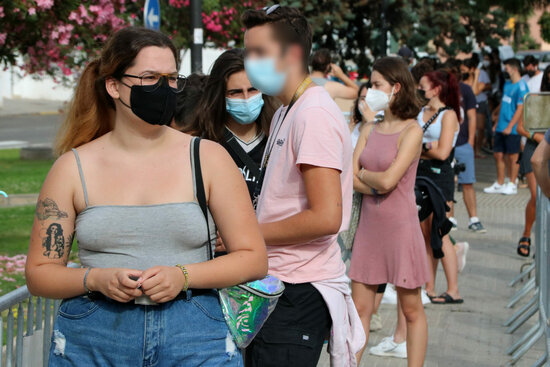Covid incidence rate on age groups getting booster shots 40% lower than average
The third vaccine leads to half of cases among ages over 50s compared to younger population

The sixth wave of the Covid-19 pandemic is affecting, in its vast majority, younger generations compared to other age groups. The arrival of the Omicron variant has skyrocketed epidemiological metrics in Catalonia.
On December 26, Catalan health ministry figures recorded that those aged younger than 50 have an incidence rate of 2,022 per 100,000 inhabitants in the last 14 days (IA14), doubling the Covid cases of those aged 50 or higher with an IA14 of 1,042, 40% compared to the Catalan average that day of 1,692 points.
Indeed, the most affected generation is the one aged 20 to 29 with an incidence rate of 2,340, a record number since the start of the pandemic. On the other hand, those aged 80 to 89 have the lowest incidence rate of 422 cases.
One of the reasons for the metrics difference is the current vaccination rollout in Catalonia. Right now, third doses are administered to the eldest population groups since September 17, 2021. Booking appointments for those aged 40 to 49, only opened on December 29.
The population between 30 to 39 represents the group with the second-highest incidence rate at 2,045 cases. Booster shots have not yet been approved for this age range.
Those who, for the moment, are only allowed to receive the first dose are children 5 to 11. Their vaccination process started on December 15, and officials agreed to leave at least eight weeks between the two doses.
For this reason, kids aged 0 to 9 were the group with the highest IA14 on December 1, at 537 cases per 100,000 people. In less than a month, the number has grown to 1,785.
Children are still on vacation due to the Christmas holidays. However, on January 10, they are supposed to return to class.
This has generated some concerns among families and schools, which is why on January 4, Spain’s health and education ministries will meet with the Spanish regions regarding the return to classes.
On December 29, Spanish PM Pedro Sánchez said that courses with vaccinated students have a lower rate of Covid cases than the unvaccinated groups.
Meanwhile, in Catalonia, Dr. Magda Campins, chair of Covid Scientific Advisory Committee, said that schools "should be the last thing to close down" as the transmission rate among younger age groups is really low.
However, returning to class on January 10 is a decision that will have to be reconsidered regarding the next days’ epidemiological data, added Campins in an interview with Catalunya Ràdio radio.
Covid-19 in Catalonia
As of December 29, 2021, official figures, released daily on this website, state there have been 1,280,601 confirmed Covid-19 cases (PCR tests and others including antibody tests).
On April 15, 2020, the Catalan health department began taking into account information on deaths declared by funeral homes on coronavirus-related fatalities, not only at hospitals, but also at care homes, other health centers, homes, and other places.
Following these criteria, as of December 29, 2021, a total of 24,572 people with or suspected to have had the virus have died since the beginning of the outbreak according to funeral homes.
Vaccine rollout in Catalonia
As of December 29, 2021, 6,296,420 residents have been given the first dose of the vaccine, 79.4% of the total population. Out of those, 5,454,932 have also been administered a second dose (68.9% of the total population). 6,072,957 residents are considered to be fully immunized (76.3%).